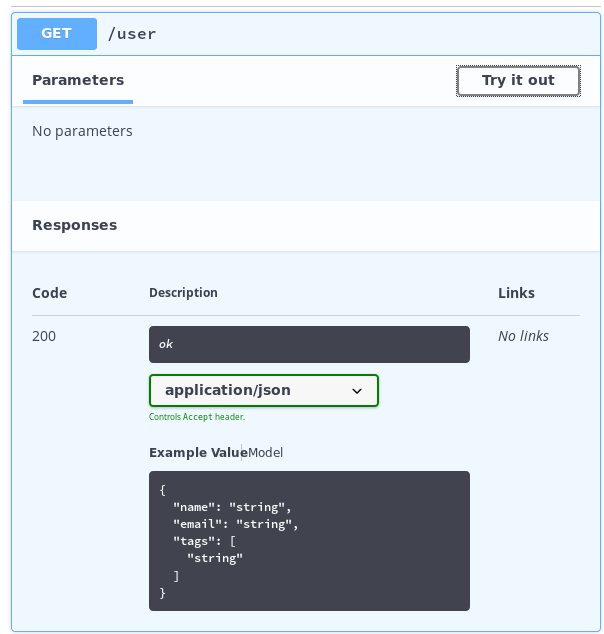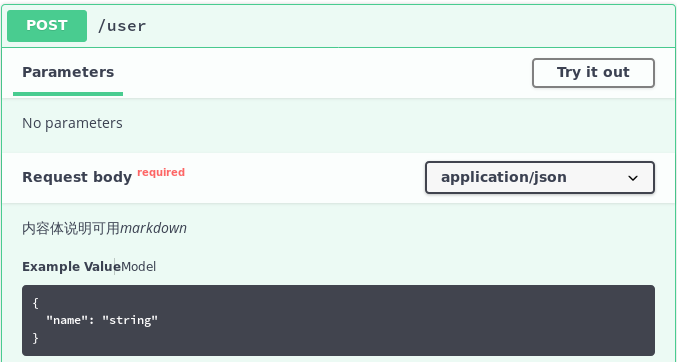【注意】最后更新于 5 年前,文中内容可能已过时,请谨慎使用。
前言
- 最近一直在用业余时间写一个个人项目,其中为了学习各种
python 新特性, 使用了各种新技术其中就使用了 openapi3 来描述 api。 - 这篇博文就来说明和封装一套生成 openapi 配置。
- 这里只讲述 openapi3 的配置结构,并与官方文档统一使用
yaml 格式来说明。 - 由于使用
python 代码中的配置与 json 格式相同。 - 在阅读此文前请自行了解
json, yaml。python 生成代码部分可无视。
一、openapi 整体结构
官方文档
1
2
3
4
5
6
7
8
9
10
11
12
| openapi: 3.0.0 # 指定openapi版本
info: # 说明当前文档信息
title: 测试 # 标题
description: 测试api # 具体说明支持 markdown
version: 0.0.1 # 版本
paths: {} # 各个url下的api说明对象
tags: [] # 分组用的tag
components: # 多次复用的一些对象
schemas: {} # 复用的数据结构
parameters: {} # 复用的请求参数
responses: {} # 复用的响应参数
securitySchemes: {} # 认证信息
|
把以上代码贴到 Swagger Editor 可以看到如下效果:

构造 ApiSpec 对象, 简单的生成配置函数
1
2
3
4
5
6
7
8
9
10
11
12
13
14
15
16
17
18
19
20
21
22
23
24
25
26
27
28
29
30
31
32
33
34
| import yaml
class ApiSpec:
def __init__(self, title, description, version):
self._paths = {}
self._tags = []
self._schemas = {}
self._parameters = {}
self._responses = {}
self._security_schemes = {}
self._spec = {
"openapi": "3.0.0",
"info": {
"title": title,
"description": description,
"version": version
},
"paths": self._paths,
"tags": self._tags,
"components": {
"schemas": self._schemas,
"parameters": self._parameters,
"responses": self._responses,
"securitySchemes": self._security_schemes
}
}
def to_dict(self):
return self._spec
def to_yaml(self):
return yaml.dump(self.to_dict())
if __name__ == "__main__":
print(ApiSpec("测试", "测试api", "0.0.1").to_yaml())
|
最终会生成如下 yaml 代码实际上是和上面的示例等价。
1
2
3
4
5
6
7
8
9
| components:
parameters: {}
responses: {}
schemas: {}
securitySchemes: {}
info: { description: "\u6D4B\u8BD5api", title: "\u6D4B\u8BD5", version: 0.0.1 }
openapi: 3.0.0
paths: {}
tags: []
|
二、添加一个 api
这里只写代码片段
响应体
path 文档
响应文档
1
2
3
4
5
6
7
8
9
10
11
12
13
14
15
16
17
18
19
20
21
22
| paths:
/user: # url
get: # 请求方法
responses: # 响应
200: # 响应状态
description: ok # 响应说明
content: # 响应内容
application/json: # 响应格式
schema: # 格式描述
type: object # 类型(integer|number|boolean|string| array|object)
properties: # object 专用用于描述各个字段
name: # 字段名
type: string # 字段类型可继续使用 object 向下继续描述
description: 名字 # 字段说明
email:
type: string
description: 邮箱
tags:
type: array
description: 标签
items: # array专用 描述item
type: string
|
- 上面的
application/json 可用换成支持的格式如 text/yaml - 暂不支持
map[string]any 之类的类型 - 显示效果:

url 参数
官方文档
1
2
3
4
5
6
7
8
9
10
11
12
13
14
15
| paths:
/user/{user_id}:
get:
parameters:
- in: path
name: user_id
schema:
type: integer
required: true
description: 用户id
- in: query
name: order
schema:
type: integer
description: 排序
|
还有一些在 Cookie, Header 中的配置,这里就不一一说明了,请自行阅读 官方文档
内容体参数
官方文档
1
2
3
4
5
6
7
8
9
10
11
12
13
14
15
16
| paths:
/user:
post:
requestBody: # 内容体描述
description: 内容体说明可用*markdown* # 说明可用markdown
required: true # 是否必须传递内容体
content: # 这里往下与 `responses` 的完全相同
application/json:
schema:
type: object
properties:
name:
type: string
responses:
200:
description: ok
|
效果:

对象引用
$ref 文档
schema 使用$ref
文章作者
上次更新
2020-06-15 18:12:42 +08:00
(9c054d8)
许可协议
CC BY-NC-ND 4.0


